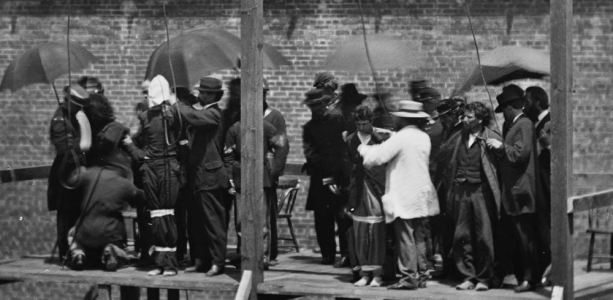July 7, 1865
It was hot that day, reportedly a 100 degrees. Sweat surely dripped down the accused’s faces as they passed by the cheap pine coffins and shallow graves that had been dug for them.
After the Lincoln assassination, the government arrested several hundred people. Most were soon released due to a lack of evidence. However, the government did charge eight people with conspiracy. On May 1, 1865, President Andrew Johnson ordered the formation of a military commission to try the accused persons.
The actual trial began on May 10th and lasted for about seven weeks. The defendants were allowed to have lawyers and witnesses, but they were not allowed to testify themselves.
A guilty verdict could come with a majority vote of the nine-member commission; death sentences required the votes of six members. The next day, it reached its verdicts. The Commission found seven of the prisoners guilty of at least one of the conspiracy charges.
Four of the prisoners: Mary Surratt, Lewis Powell, George Atzerodt, and David Herold were sentenced “to be hanged by the neck until he [or she] be dead”.
Samuel Arnold, Dr. Samuel Mudd, and Michael O’Laughlen were sentenced to “hard labor for life, at such place at the President shall direct”, Edman Spangler received a six-year sentence. The next day General Hartrandft informed the prisoners of their sentences. He told the four condemned prisoners that they would hang the next day.
Shortly after the afternoon of July 7, 1865, the four condemned conspirators were forced to climb the hastily built gallows that they had heard being tested the night before from their prison cells.
More than 1,000 people—including government officials, members of the U.S. armed forces, friends and family of the accused, official witnesses, and reporters—had come with their exclusive tickets to see this execution.
Nooses were placed around the accused’s necks and hoods over their heads. Ever since the sentences had been handed down a week ago, Surratt’s lawyers and her daughter Anna had been fighting and pleading for her death sentence to be changed.
After the last rites and shortly after 1:30 PM, the trap door was opened and all four fell. It was reported that Atzerodt yelled at this very last moment: “May we meet in another world”. Within minutes, they were all dead.
The bodies continued to hang and swing for another 25 minutes before they were cut down.
Over the years, critics have attacked the verdicts, sentences, and procedures of the 1865 Military Commission. These critics have called the sentences unduly harsh and criticized the rule allowing the death penalty to be imposed with a two-thirds vote of Commission members.
The hanging of Mary Surratt, the first woman ever executed by the United States, has been a particular focus of criticism. Critics also have complained about the standard of proof, the lack of opportunity for defense counsel to adequately prepare for the trial, the withholding of potentially exculpatory evidence, and the Commission’s rule forbidding the prisoners from testifying on their own behalf.









